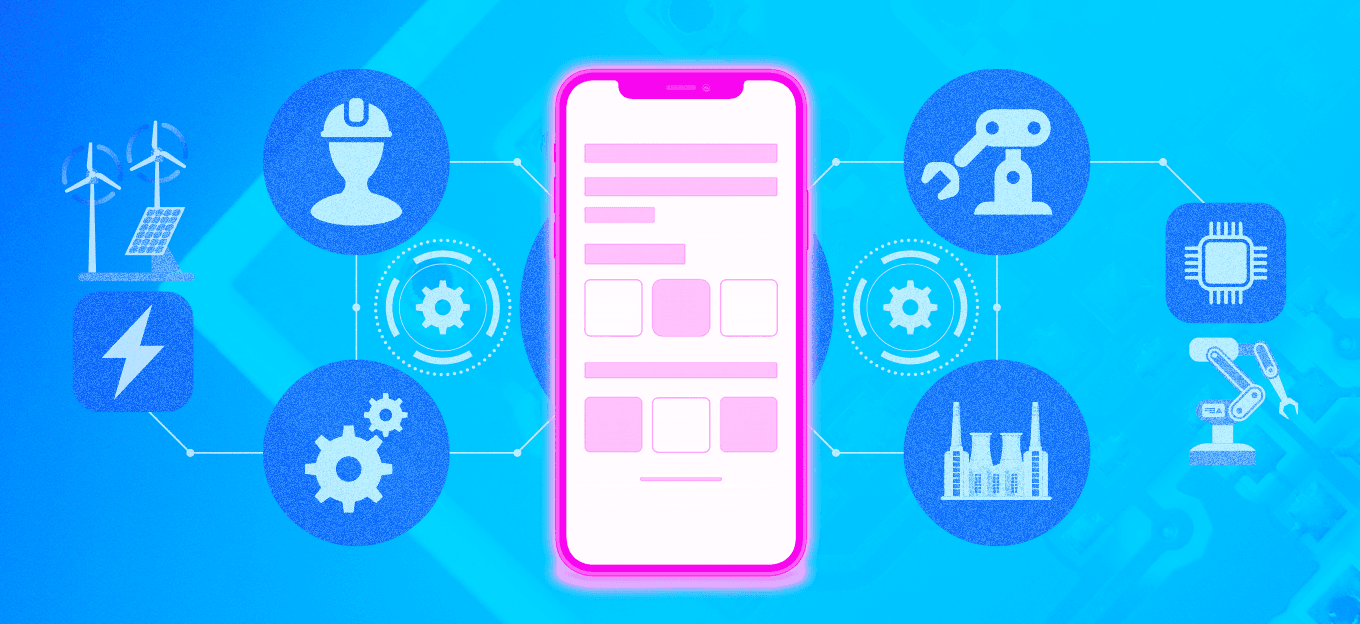How Enterprise Mobile Apps Unlock Real-Time Device Control in IoT Systems
How Enterprise Mobile Apps Unlock Real-Time Device Control in IoT Systems
- Last Updated: October 21, 2025
Octal IT Solution
- Last Updated: October 21, 2025



The Internet of Things (IoT) is a foundational element of contemporary digital transformation. In the healthcare sector, as well as in logistics, retail, and manufacturing, devices connected through IoT are helping organizations gather data, streamline processes, and enhance customer experiences. Nevertheless, with the development of the IoT networks, the complexity of their control and administration increases. However, in the case of enterprises, the issue is to ensure that not only related systems are monitored, but also managed efficiently and in real-time.
This is where enterprise mobile app development comes in with the transformative role to play. By combining the availability of mobile technology with the intelligence of the IoT, businesses will be able to provide employees, managers, and even customers with the ability to communicate directly with connected devices via their smartphones or tablets. It takes interactive enterprise software to manage any situation that requires specialized dashboards and on-site staff, allowing for seamless management at any time and location.
Enterprises with real-time device control acquire agility, expediency in decision-making, and increased efficiency. This is no longer a competitive edge; it is rapidly becoming a mandatory requirement for enterprises interested in realizing the full potential of the IoT system.
The Power of Enterprise Mobile Apps in IoT Ecosystems
The majority of systems used in the initial phase of IoT were based on web-based dashboards or background monitoring devices. These platforms were effective but were not accessible to workers and managers who were not in the office. Enterprise mobile apps redefined the situation by putting IoT control into the hands of the users.
An example is a manufacturing plant manager who can monitor the status of linked machines, change settings, and receive real-time notifications when a failure occurs, even without being physically present on the factory floor, using a mobile application. Equally, within healthcare, enterprise applications enable physicians and nurses to view patient vital measurements recorded by IoT-based devices and make real-time decisions once critical levels are reached.
Enterprise mobile app development makes this convenience and control possible by creating apps with specific features that meet the needs of a particular organization. In contrast to consumer apps, enterprise apps are deeply integrated with IoT infrastructure, enabling real-time communication between devices, cloud platforms, and end-users.
Bridging the Gap Between IoT Deployment and Business Needs
An effective IoT ecosystem begins with the implementation of IoT, which involves integrating communication systems, sensors, and devices into an organization's workflow. Although deployment provides the groundwork, the key challenge is to make this data useful and responsive. Without an easy and instinctive means of communicating with machines, employees would not readily adopt it, and companies would not fully utilize their investments in IoT.
Enterprise apps address this issue by providing an interface that integrates raw IoT data with practical and user-friendly controls. Rather than using complicated dashboards, end-users can communicate with the system using conversational protocols, touch-based interfaces, or real-time notifications.
Take the example of a logistics company that has thousands of vehicles fitted with IoT sensors. With an enterprise application, fleet managers have an opportunity to monitor the position of every vehicle, its fuel efficiency, and cargo status. They are also able to divert the traffic in real-time when there is a traffic update or a change in weather. This direct connection between IoT deployment and the functionality of enterprise apps is crucial to ensure that businesses are not only gathering information but also processing it in real-time.
Additionally, mobile applications make it easy to administer devices to all employees, even those who may lack technical skills. Enterprise apps make the Internet of Things easier within an organization by hiding complexity behind user-friendly interfaces.
Smarter Workflows Through Enterprise Application Development
IoT is not only about the interaction between devices, but also about making work processes more efficient and smarter. The development of enterprise applications is a key factor in this, as it has enabled apps to take an additional step beyond monitoring and transform into intelligent control systems.
For example, predictive analytics can be integrated into enterprise applications within industrial IoT. A machine connected to it can send vibration or temperature information that will show a coming failure. The app notifies the supervisor before a breakdown happens, proposes proactive measures, and even automatically schedules repair. This proactive approach, rather than a reactive one, saves time, minimizes downtime, and decreases the operational cost.
Besides, enterprise application development is aimed at converting the raw IoT data into actionable insights. In intelligent building management, such as in smart buildings, IoT can be used to monitor the use of energy, lighting, and HVAC. An enterprise application can bring this information together and display it through coherent visualizations, enabling managers to recognize inefficiencies and make informed decisions.
Intelligence integrated into applications enables businesses to develop IoT ecosystems that are connected, responsive, predictive, and adaptive.
Real-Time Device Control as a Strategic Differentiator
In the current competitive world, business organizations cannot do away with delays in decision-making. Live device management is emerging as a competitive edge that divides market leaders and followers. Enterprise mobile app development also allows business organizations to control the interconnected devices across geographies, thereby making business operations run smoothly even in a global network.
As an example, an energy provider would be able to remotely adjust the power distribution of smart grids with the help of mobile apps, which would guarantee the efficient work of the latter and a quick reaction to outages. Equally, a retail chain is able to track and manipulate inventory management systems in several stores in real-time.
The capability of immediate action saves time, improves customer satisfaction, and operational efficiency. It turns the IoT systems into proactive data collection systems into active ecosystems of action that take action upon realization. Enterprise apps, in this manner, make IoT not only smarter but also faster and more responsive.
Enhancing IoT Deployment with Mobility
The scalability of the IoT is its greatest strength; however, it also has its drawbacks. With the increased integration of IoT among organizations in terms of the scale of devices, the areas, and applications, managing the complexity becomes a challenge. This is where IoT implementation cannot do without mobile apps.
Enterprise mobile applications will enable companies to build IoT processes without the need to strain their workforce. It can be controlling thousands of sensors in a smart city or tracking direct patient health in a big hospital system, but apps have centralized and yet mobile-friendly control mechanisms.
The future implementation of IoT will be more dependent on mobile, with voice recognition, AR/VR, and AI-based virtual assistants. Employees and other stakeholders will find it even simpler to communicate with intricate IoT ecosystems using natural and instinctive means with these advances.
Future of Enterprise Application Development in IoT
Enterprise apps will change as IoT technology also changes. Application development in enterprises is now moving towards the development of multi-modal and intelligent interfaces with a mix of voice, gestures, and AI-driven insights. Future apps will not be confined to screens and will provide immersive experiences that will guide users more effectively through the IoT ecosystems.
Security will also be given a first priority. The more IoT networks are developed, the more threats can be encountered. Enterprise applications will be combined with modern authentication and encryption to secure control over devices and meet industry standards.
Furthermore, the next-generation applications will be seamlessly connected to enterprise systems like ERP, CRM, and analytics tools, forming a whole ecosystem in which the data of IoT has an impact on the larger business initiatives.
Real-World Benefits Across Industries
The IoT sector and its use with enterprise applications is not exclusive to one industry- there are revolutionary uses of this combination in business:
- Healthcare: Physicians can use enterprise apps to track patient vitals in real-time so that they can intervene faster.
- Logistics: The IoT-linked apps allow fleet managers to monitor shipments, optimize shipping routes, and lower fuel expenses.
- Manufacturing: Predictive notifications about equipment performance are provided to supervisors, reducing downtime.
- Retail: Managers can track inventory, energy consumption, and customer behavior within stores to optimize operations.
In all scenarios, enterprise apps enable companies to manage devices in real time, enabling them to unlock efficiency, safety, and customer satisfaction.
Conclusion
The IoT revolution is not about connecting the devices anymore, but enabling enterprises to manage the devices in real time. The development of enterprise mobile applications is the key to the successful connection between IoT systems and decision-makers that will guarantee smooth communication and actionable information.
Enterprise apps make it easier to manage devices, enhance adoption, and achieve operational flexibility when integrated with strategic IoT implementation. On the other hand, the enterprise application development makes sure that these applications are developed into intelligent platforms that have capabilities of predictive analysis, proactive control, and secure business system integration.
The market of enterprise apps is only going to become more powerful as industries start using IoT on a large scale. Real-time device control is not only a technological enhancement but the key to creating smarter, faster, and more competitive companies.
The Most Comprehensive IoT Newsletter for Enterprises
Showcasing the highest-quality content, resources, news, and insights from the world of the Internet of Things. Subscribe to remain informed and up-to-date.
New Podcast Episode

Moving Past the Pilot Phase in IoT and AI
Related Articles

